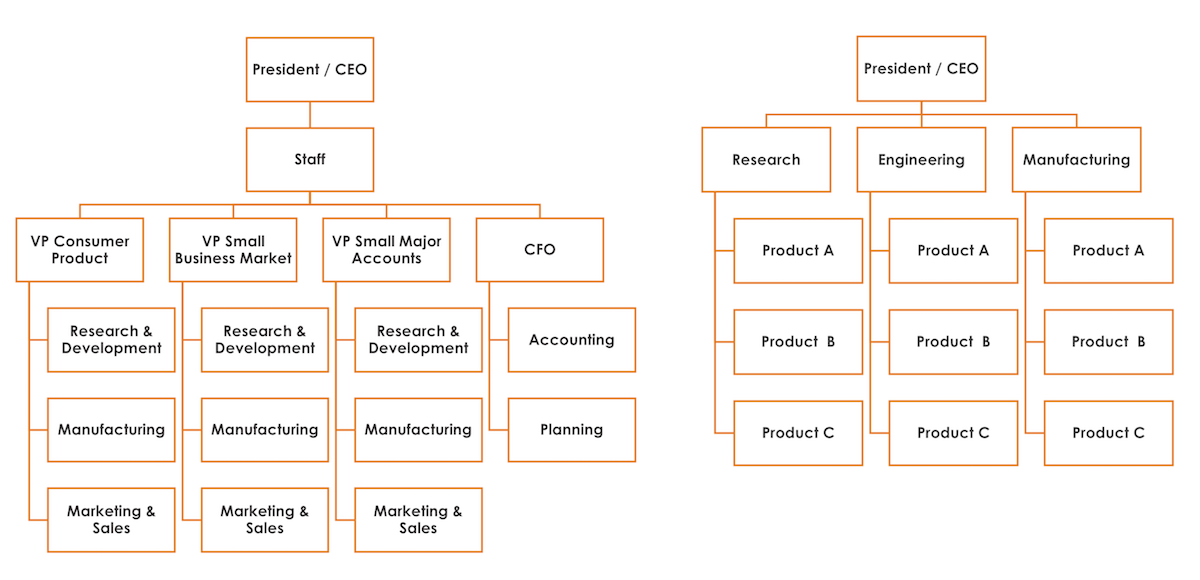Complexity.
Few marketers would argue that this does not aptly describe today’s marketing landscape. With the fierce competition for sales, new customers, channel dominance and the most relevant content, the challenges are constant. When you add the complexities of today’s modern matrix organizations to the mix, marketing solutions rarely fall into the “quick and easy” category.
Simantel has worked with B2B matrix organizations for decades, and in our experience, the most effective matrix organization marketing isn’t a one-person job; it requires a collaborative team effort. Here we’ve captured some of the most successful methods we’ve seen for tackling matrix marketing challenges.
Let’s start by making sure that we’re all on the same page with the structure of a matrix organization.
What is a Matrix Organization?
A matrix organization structure is one in which the lines of reporting are set up as an inter-connected grid (or matrix) rather than a more traditional vertical hierarchy. This means that employees will have multiple people to report to – usually a product or product segment manager and a project manager.
In the 1970s, Philips, at that time one of the world’s largest electronics companies, set up matrix management with its managers reporting to both a geographical manager and a product division manager. Many other large corporations including Caterpillar Inc., Hughes Aircraft and Texas Instruments, also adopted matrix reporting structures. More recently, Amazon’s matrix structure for distribution has shown the world how to get it delivered!
Matrix Organization Advantages
Matrix structures are adopted because they give management multiple points of view—they can get reports from functional (finance, manufacturing), geographic (by region or country) or product (sedans, trucks, SUVs) lines. Some advantages over more traditional vertical structures include:
- Inputs for work are not isolated, but rather are shared across groups.
- People learn the value of working collaboratively and interdependently because teamwork gets better results.
- There are more opportunities to share information, which improves the entire organization, not just one part of it.
Matrix Organization Challenges
But like all things that have a positive impact, in our less-than-ideal world, there can also be challenges. While the matrix structure’s purpose is to encourage more independent thinking and accountability, these very qualities can create barriers to coherent marketing. Without strong communication and collaboration between groups, they may see the customer experience differently. Differing views on the customer journey can result in marketing strategies that collide with each other rather than enhance each other. In an already complex marketing environment, the result can be some real customer confusion and loss of sales or market share.
Whether you work inside a matrix organization or work with one, understanding these challenges and how to deal with them can help your marketing teams make better decisions.
Matrix Organization Marketing Challenges 1: Where Can We Get the Answers We Need?
Matrix organizations support collaboration but often struggle with knowledge sharing across the matrix. As a result, here are some typical outcomes:
- Knowledge and expertise tend to live in individuals rather than in an organization. This can be challenging as access to content providers is limited.
- Information about customers and their behaviors and preferences can reside with different groups – product development, sales, product support service or distribution. The same may be true of mergers, new product and competitive intelligence.
- Meaningful insights aren’t available because there is no one to compile information and look across all the different findings.
Tips for Getting Information & Answers
Statistical findings confirm over and over again that content is critical to successful marketing efforts. While matrix organizations are usually rich in content, they often struggle with sharing and making it accessible. While you can’t stage your own reorg of the company, there are some actions you can take to help:
- Avoid the technology trap.
There are lots of marketing tools and platforms out there that position themselves as your information warehouse solution. In reality, technology alone can’t solve the problem. In most cases you need to get people onboard and committed to sharing first. Once you confirm how it works best in your process, technology support choices will be clearer. - Be a “starter” for sharing relevant knowledge.
It is cliché to say, “If you want something done, do it yourself.” So, let’s flip that to “If you want something done, lead the way.” Find an opportunity for sharing your valuable knowledge.- Wherever your group shares information, post there as often as you can.
- For each of your projects, connect with at least one person outside your group with your insights or results. Ask for others to do the same.
- Matrix organizations usually have some sort of intergroup meetings on a regular basis. Suggest (or volunteer) people to present relevant information to the group and make it part of the meeting notes. The regular distribution of the notes will expand information access to others.
- Whenever you attend workshops, conferences or trade shows, make it a habit to share relevant information with your groups. Ask others to do the same. Matrix cultures generally support reciprocity.
- Get out of the box and create a “share your knowledge” communication. The more people you engage, the more likely information will get shared.
- Reach out to teams managing data-driven marketing efforts.
People who manage your company website, your media execution and/or your marketing automation efforts may have great insights that you can leverage in your own projects. If you have agency partners, build project summaries and results documents into their scope of work. This can be a great reference for strategy and content development, orienting new employees and sharing with other groups. - Connect with company marketing partners.
If your company has a list of preferred marketing providers, you may find them to be a good source of marketing information and resources. If they have a longstanding relationship with your company, they may have staff who have information from marketing research, customer conferences and events, and other marketing and/or sales functions. Find them.
Matrix Organization Marketing Challenge 2: There’s a Gap Between Marketing, Service and Distribution
In matrix organizations, it’s not unusual for the responsibility for distributors to be spread between marketing groups and product support or service groups. If these groups don’t communicate with each other and create a coherent view of the customer journey both pre and post-sale, customers are likely to receive a fragmented experience. Here are some ways to bring more continuity to your customers’ interaction with your marketing efforts.
- Advocate for collaborative workshops when it comes to your marketing strategy.
There is no better way to find common ground than to get the key stakeholders in a room and reach consensus as much as possible. Workshops play a key role in our strategy process at Simantel, and we have found that there are always valuable insights that arise when all the different points of view can explore how they impact each other. - Build information gathering interviews into your projects.
Interviews with distributors and customer service people can reveal valuable customer insights that shape marketing strategy and content. It is a small investment in time and resources that can help tie all the key milestones of the customer experience more closely together. - Get service and distributor feedback when possible.
These people are closest to your customers and potential customers. In addition to promoting your brand, they also promote their own brand and services. Sharing marketing ideas, content and design concepts with them may help connect marketing more effectively to the customer’s post-purchase. This is critically important as it can lead to repeat buying behaviors and greater brand loyalty.
Matrix Organization Marketing Challenge 3: We Need More Resources!
The collaborative nature of matrix organizations also drives expectations for multi-tasking. For example, an industry marketing group may have responsibility for the analysis and reporting of actual sales, as well as determining the marketing strategy that will most effectively drive sales results to corporate targets. As the size of their product responsibility grows, so does the need for resources – a need that isn’t always met.
Tips for Overcoming Insufficient Marketing Resources
Marketing is often a matter of timing. If there aren’t enough resources to pull it all together, opportunities may be lost. Here are some ideas to find the resources when you need them:
- Optimize project management.
Project management and project status are often confused. Project status work develops calendars and due dates. When there is deviation from the plan, it’s reported. Project management considers resources and workload in the mix. Encourage your teams to manage projects as a team…not just as individual calendars. - Reach out to other groups for help.
A common part of the matrix management style is to assign people special projects or assignments as they have bandwidth to do so. To work well, team cultures need to have open boundaries to this level of collaboration. You may be able to find the win-win by identifying someone who gets an advantage in their work from helping you with yours. So scout out potential reinforcements, and ask for assistance! - Explore outsourced relationships.
Because of their flexible, collaborative nature, matrix structures typically interface with external resources effectively. Today’s marketing workforce includes independent consultants, project posting/bid sites of all sorts, as well as full-service agencies – find what works best for you. In our experience, the more proactive you are at building these relationships the better, because it will save time and money when there is an urgent need. - Recruit retirees.
Matrix organization retirees often possess a wealth of knowledge built from all their experiences. If available to you, they can not only help complete work but can also enrich your team with insights.
Communication and Collaboration Are Key
Our marketing landscape isn’t likely to become less complex in the near future, but by focusing on communication and collaboration, we can bring greater clarity to it…and tackle a few more challenges.
Sources:
Carol Woods
“Matrix Organizational Structure: Advantages, Disadvantages & Examples.” Study.com, 22 September 2014, study.com/academy/lesson/matrix-organizational-structure-advantages-disadvantages-examples.html
“In Praise Of Matrix Organizations,” George Bradt, Senior Contributor Leadership Strategy, Forbes, October 19, 2018.






